RESOURCE ARTICLE
AARRR Pirate Metrics Framework for SaaS
The AARRR Pirate Metrics framework is one of the most widely used models for tracking SaaS growth. Developed by Dave McClure, it breaks the customer journey into five clear stages: acquisition, activation, retention, revenue, and referrals. Each stage highlights a different point where user behavior directly impacts growth.
For SaaS founders and teams, the framework offers more than just metrics. It provides a structured way to identify bottlenecks, measure performance, and focus energy where it matters most. Instead of chasing vanity numbers like downloads or clicks, AARRR ensures attention stays on behaviors that translate into long-term business value.
By applying Pirate Metrics, startups gain a roadmap for scaling efficiently. Whether the goal is to improve onboarding, reduce churn, or build viral referral loops, the framework helps companies prioritize actions that drive sustainable growth rather than short-lived spikes.
Before moving ahead, it is important to understand why so many SaaS startups fail to grow in the first place.
Why SaaS Startups Fail to Grow?
The SaaS market is booming, but survival is far from guaranteed. According to Rocking Web, 92 percent of SaaS startups fail within three years, with nearly half collapsing during the tough 18-to-24-month period often called the “valley of death.” The challenge is not always a lack of demand but the difficulty of scaling in a sustainable way.
There are several recurring reasons behind this high failure rate:
- High churn rates: Customers leave quickly when products do not deliver consistent value, creating constant pressure to replace lost revenue.
- Weak onboarding: If new users cannot experience value fast enough, they abandon the product before becoming engaged.
- Inefficient acquisition: Relying heavily on expensive ads or poorly targeted campaigns drains budgets without generating long-term growth.
- Fragile revenue models: Pricing that does not align with customer willingness to pay or fails to support recurring value leads to unsustainable economics.
- Lack of structured growth tracking: Many startups push for short-term wins but lack a system to measure and improve performance across the customer journey.
What makes these challenges even tougher is that they are interconnected. Weak onboarding leads to poor retention. Poor retention inflates acquisition costs. Fragile revenue models cannot fund innovation. Without a structured framework, startups often waste energy on surface-level growth while deeper cracks remain hidden.
This is where the AARRR framework, also known as Pirate Metrics, comes in. Introduced by Dave McClure, AARRR gives SaaS businesses a simple but powerful model to track growth across five stages:
- Acquisition – How people discover your product
- Activation – When they experience value for the first time
- Retention – Whether they continue to return and engage
- Revenue – How effectively you monetize
- Referrals – How customers spread the word to others
In this guide, we will explore each stage with formulas, SaaS benchmarks, examples, and strategies you can apply to your own business.
What Does the AARRR Funnel Look Like at a Glance?
The AARRR funnel gives a simple way to visualize how customers move through your SaaS journey. It starts with awareness and acquisition at the top, then narrows down as users activate, stay engaged, generate revenue, and finally bring in others through referrals. Each stage represents a critical checkpoint in turning a curious visitor into a loyal advocate.
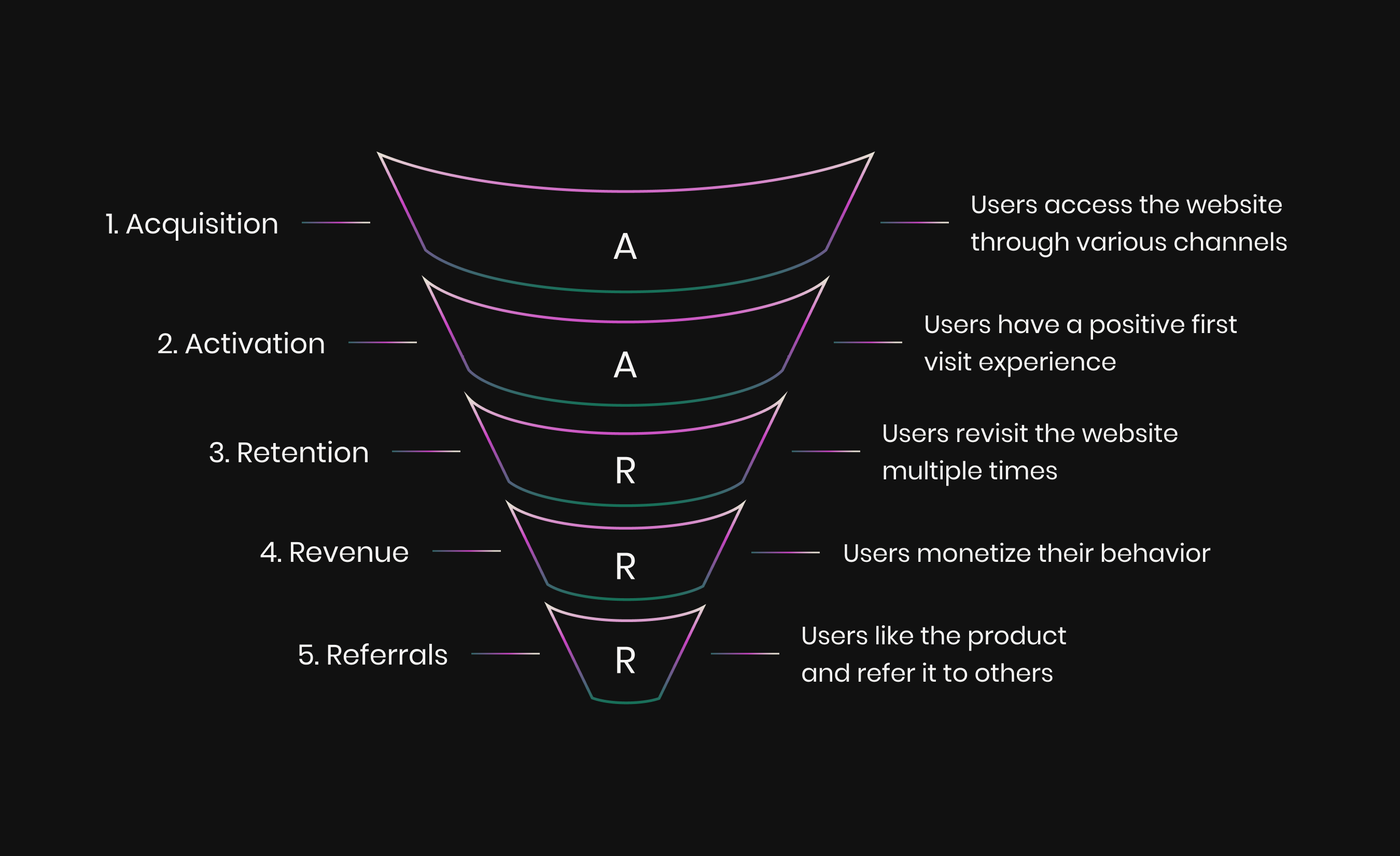
Looking at the funnel helps founders and teams see growth as a connected system rather than isolated actions. If one stage breaks, the rest of the funnel suffers. For example, spending heavily on acquisition is wasted if activation is poor, while great onboarding means little if retention is weak. By mapping metrics across the funnel, you can identify where to focus and avoid guesswork.
The real power of the AARRR funnel lies in optimization. Improving even a small percentage at each stage creates compounding growth across the entire system. A slightly higher activation rate, better retention strategy, or stronger referral loop can turn steady progress into exponential results.
Acquisition: How Do Users Find You?
Acquisition is the entry point to the AARRR funnel. It is all about how potential customers first discover your product and decide to take a closer look. For SaaS companies, this discovery can happen in many ways: through organic search, paid advertising, peer recommendations, integration marketplaces, or product-led initiatives like free trials. The strength of your acquisition strategy determines the quality and volume of leads entering the funnel, which in turn impacts every stage that follows.
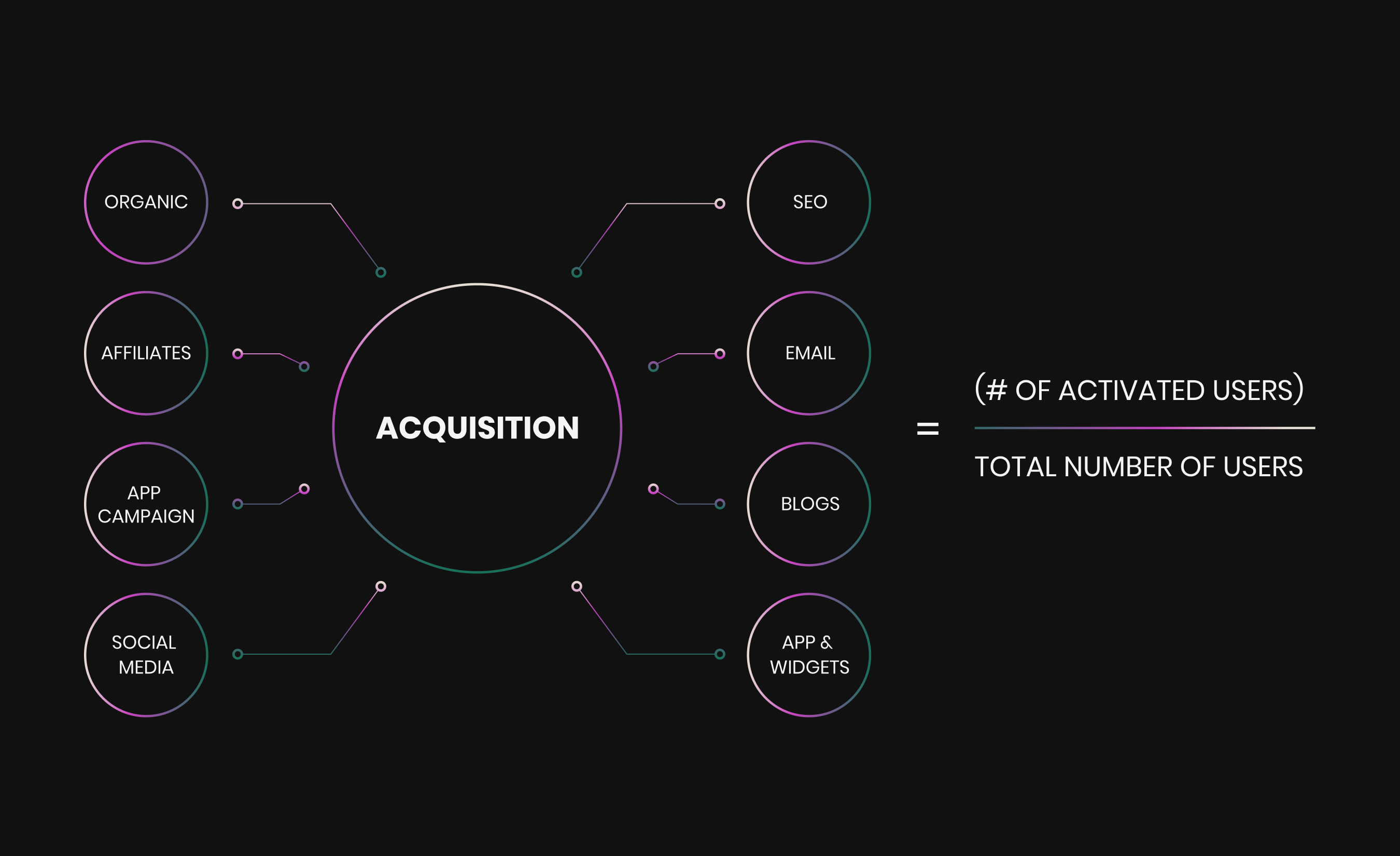
Key Metrics and Formulas
Measuring acquisition requires more than simply tracking signups. The goal is to understand efficiency, cost, and conversion quality.
- Customer Acquisition Cost (CAC) = Total sales and marketing spend ÷ Number of new customers
- CAC Payback Period = CAC ÷ Monthly gross margin per customer
- Lead Conversion Rate = (Qualified leads ÷ Total leads) × 100
These formulas help SaaS teams see not just how many customers they are acquiring, but whether the approach is financially sustainable.
Benchmarks
Industry research shows that:
- The average SaaS CAC payback period is between 12 and 18 months. A shorter payback period means faster capital recovery and more flexibility for growth.
- Paid acquisition CAC is usually 15 to 30 percent higher than organic or product-led channels, which makes content-driven and viral strategies more cost-effective over time.
Tactics That Drive Acquisition
- High-quality SEO-driven content marketing
- Product-led growth through free trials or freemium plans
- Paid campaigns that target high-intent searches
- Listing in marketplaces or app directories such as Slack or HubSpot
- Strategic partnerships and referral incentives
Activation: Do Users Experience Value Quickly?
Acquisition may get users through the door, but activation is what convinces them to stay. It is the stage where curiosity turns into commitment. Activation is not just about signing up or logging in; it is about the first time a user truly experiences the value your product promises. For Dropbox, this was when a user uploaded their first file. For Slack, it was sending the first team message. For Canva, it was designing and sharing a graphic in minutes without professional help.
When users hit this “aha” moment, they begin to understand why your product matters and how it can solve their problem better than alternatives. Without activation, signups remain shallow, churn rates climb, and marketing investments fail to produce long-term results. This is why strong onboarding and carefully designed product experiences are essential. They bridge the gap between initial interest and lasting engagement.
Activation Formula
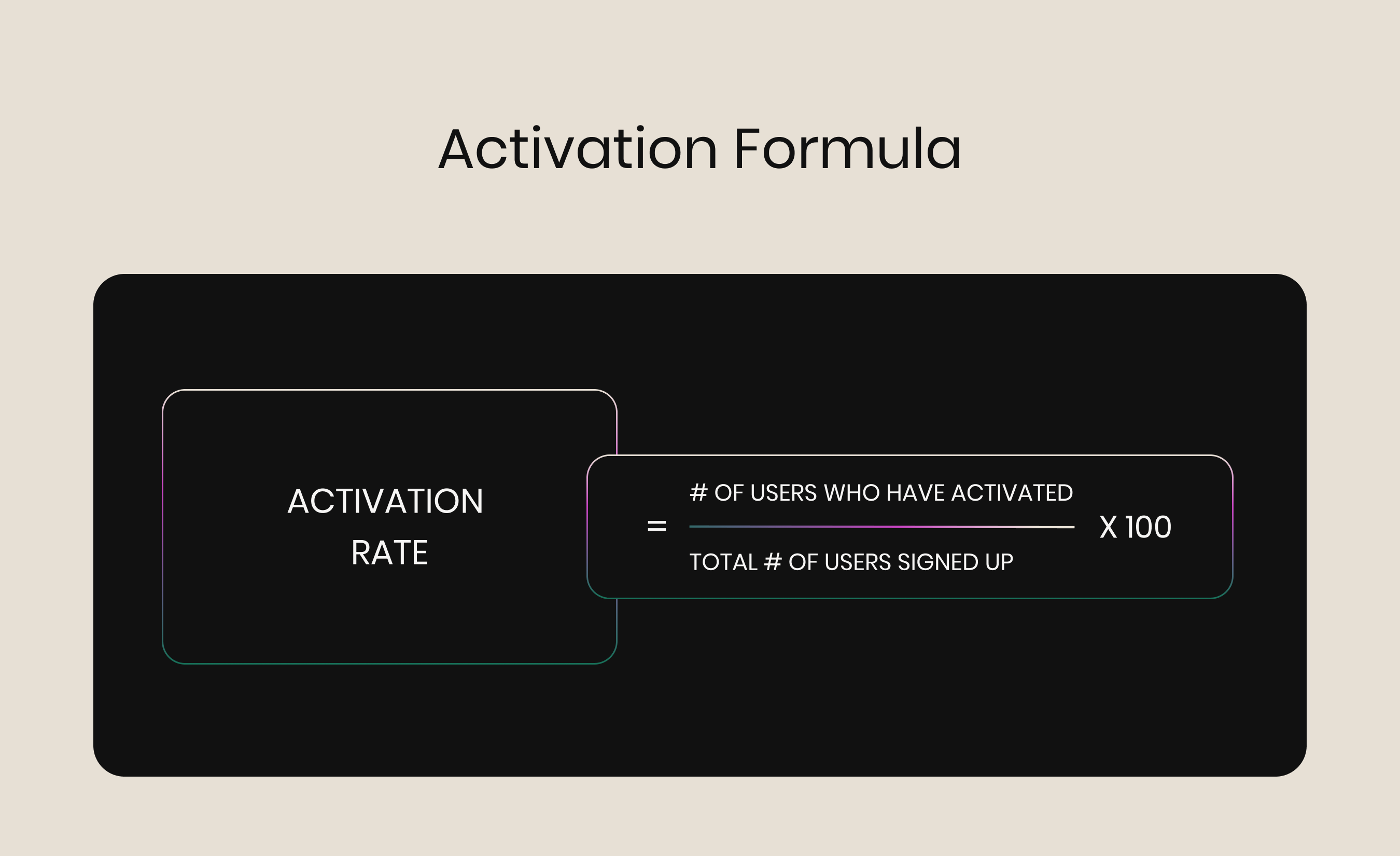
Activation Rate = (Number of users who reached activation milestone ÷ Total signups) × 100
SaaS Benchmarks
- Average activation rate: 20 to 40 percent
- Strong onboarding processes can push activation rates above 50 percent
Onboarding Checklist
- Send a clear welcome email with setup steps
- Provide an in-app guided tour or product walkthrough
- Define one simple first action, such as creating a project or uploading a file
- Celebrate the milestone with a success notification
Retention: Do Customers Stick Around?
Retention is often the most critical stage in SaaS growth because it determines whether your business can build a stable foundation or remain stuck in survival mode. Without strong retention, acquisition and activation are nothing more than expensive short-term wins. You may attract attention with ads or convert signups with great onboarding, but if customers leave after a month or two, the cycle becomes unsustainable.
A company that fails to retain customers is forced to spend heavily just to stand still. Every lost user must be replaced with a new one, which drives up acquisition costs and stretches marketing budgets. This creates a dangerous treadmill effect where growth feels constant on the surface but revenue stalls underneath.
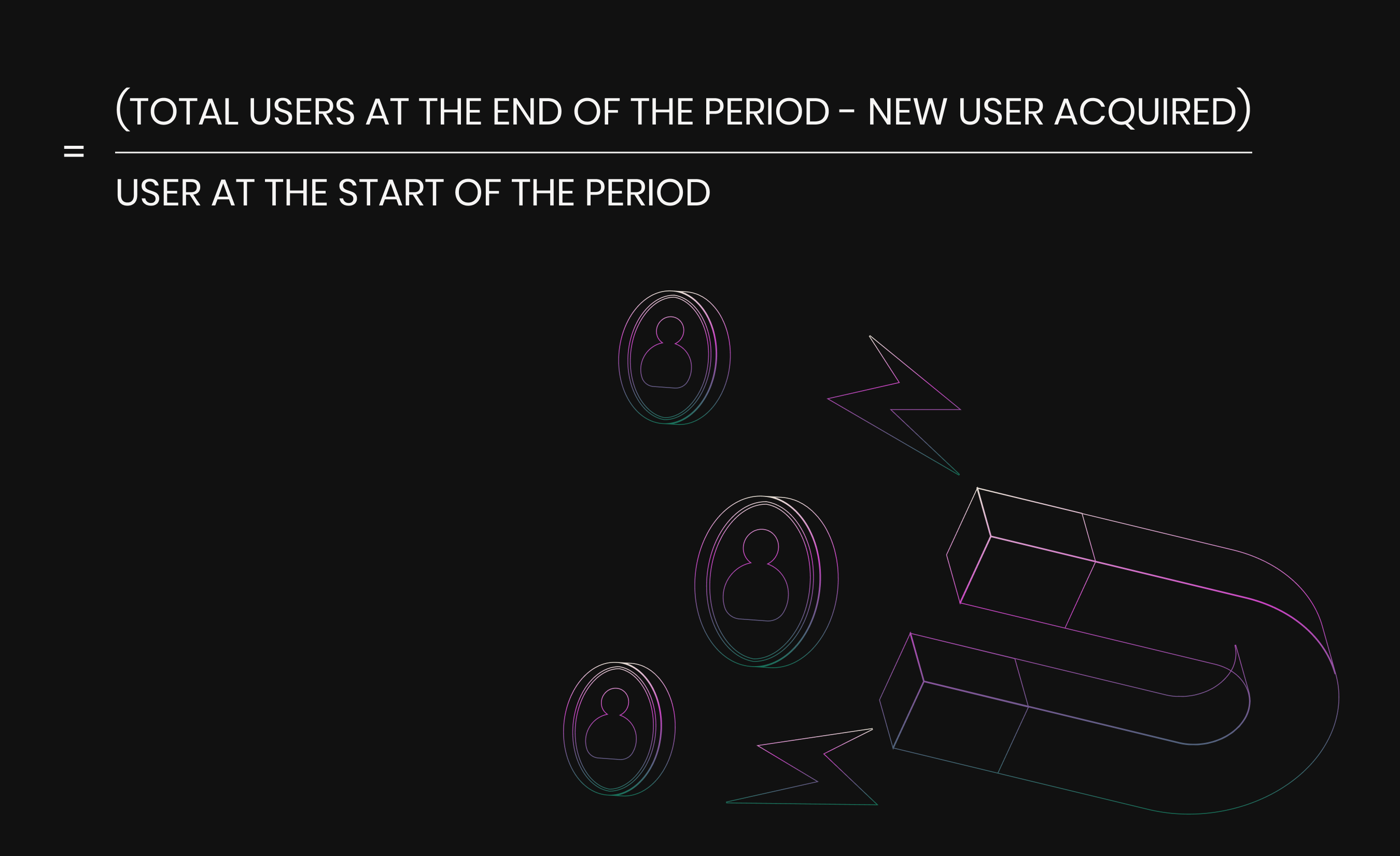
Strong retention, on the other hand, compounds value. Loyal customers not only renew subscriptions but also expand usage, upgrade to higher tiers, and become advocates who bring in referrals. This reduces dependency on constant acquisition, stabilizes cash flow, and gives the business room to invest in product innovation. In many ways, retention is the true measure of whether your SaaS is solving a real problem and delivering ongoing value.
Retention Formulas
- Churn Rate = (Customers lost ÷ Customers at start of period) × 100
- Net Revenue Retention (NRR) = (Recurring revenue this period ÷ Recurring revenue previous period) × 100
- Customer Lifetime Value (LTV) = (ARPU × Gross Margin %) ÷ Churn Rate
SaaS Benchmarks
- Average monthly churn: 3 to 5 percent
- Enterprise SaaS churn: less than 2 percent
- Top quartile NRR: above 120 percent
Retention Tactics
- In-app surveys and Net Promoter Score (NPS) programs to capture feedback
- Personalized lifecycle emails triggered by usage patterns
- Regular customer success check-ins for high-value accounts
- Loyalty rewards or tiered benefits for long-term users
Revenue: How Do You Monetize?
Revenue is the stage where the value you create for customers finally translates into measurable financial growth. It is the proof point that your product is not only useful but also worth paying for on a recurring basis. Strong revenue performance does more than keep the business alive. It shows that customers see enough ongoing value to invest their money month after month, which is a clear sign of product-market fit.
For founders and teams, revenue is more than just a number on a balance sheet. It reflects the strength of your pricing strategy, the clarity of your value proposition, and the effectiveness of your customer journey. Healthy revenue metrics also send an important message to investors and stakeholders: the business model is working, the product can scale, and growth is sustainable.
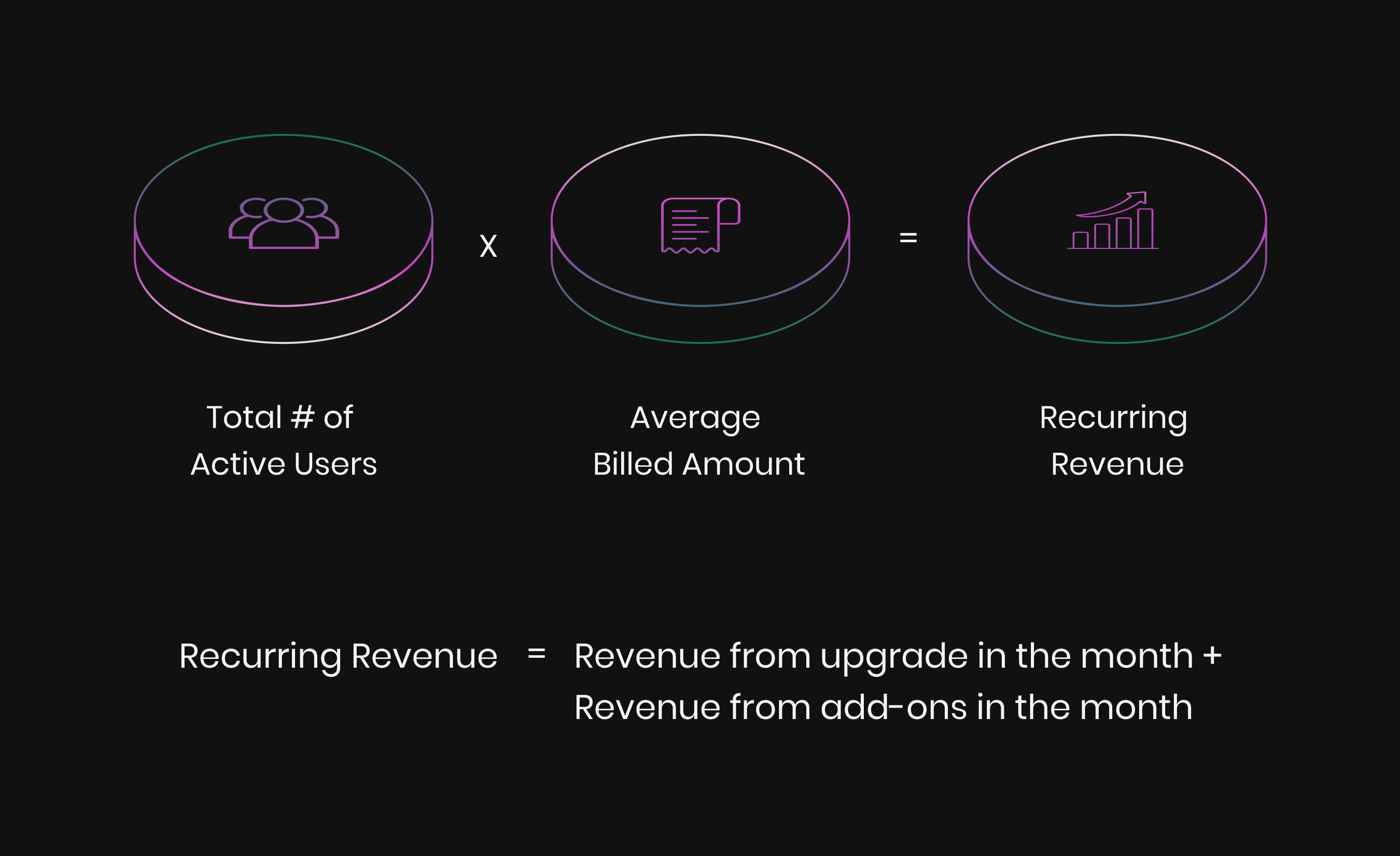
When revenue is consistent and predictable, SaaS companies gain the flexibility to reinvest in innovation, expand into new markets, and build customer success programs. This stability becomes the fuel for long-term growth, turning satisfied users into loyal customers and loyal customers into profitable advocates.
Key Formulas
- Monthly Recurring Revenue (MRR) = Σ monthly subscription revenue
- Annual Recurring Revenue (ARR) = MRR × 12
- Average Revenue Per User (ARPU) = Total revenue ÷ Active users
- LTV: CAC Ratio = Customer lifetime value ÷ CAC
SaaS Benchmarks
- A healthy LTV: CAC ratio is around 3:1
- Gross margins typically fall between 70 and 80 percent for SaaS
Example Revenue Table
Referrals: Do Users Bring Others?
Referrals are the final stage of the AARRR framework and often the most overlooked. They represent the moment when satisfied customers go beyond using your product and actively promote it to others. This stage turns loyal users into advocates who amplify your growth without additional acquisition spending.
Unlike paid ads or outbound sales, referrals carry the power of trust. A recommendation from a friend, colleague, or peer has far greater influence than a marketing campaign because it is rooted in personal experience. This makes referrals one of the most cost-effective growth levers available to SaaS companies.
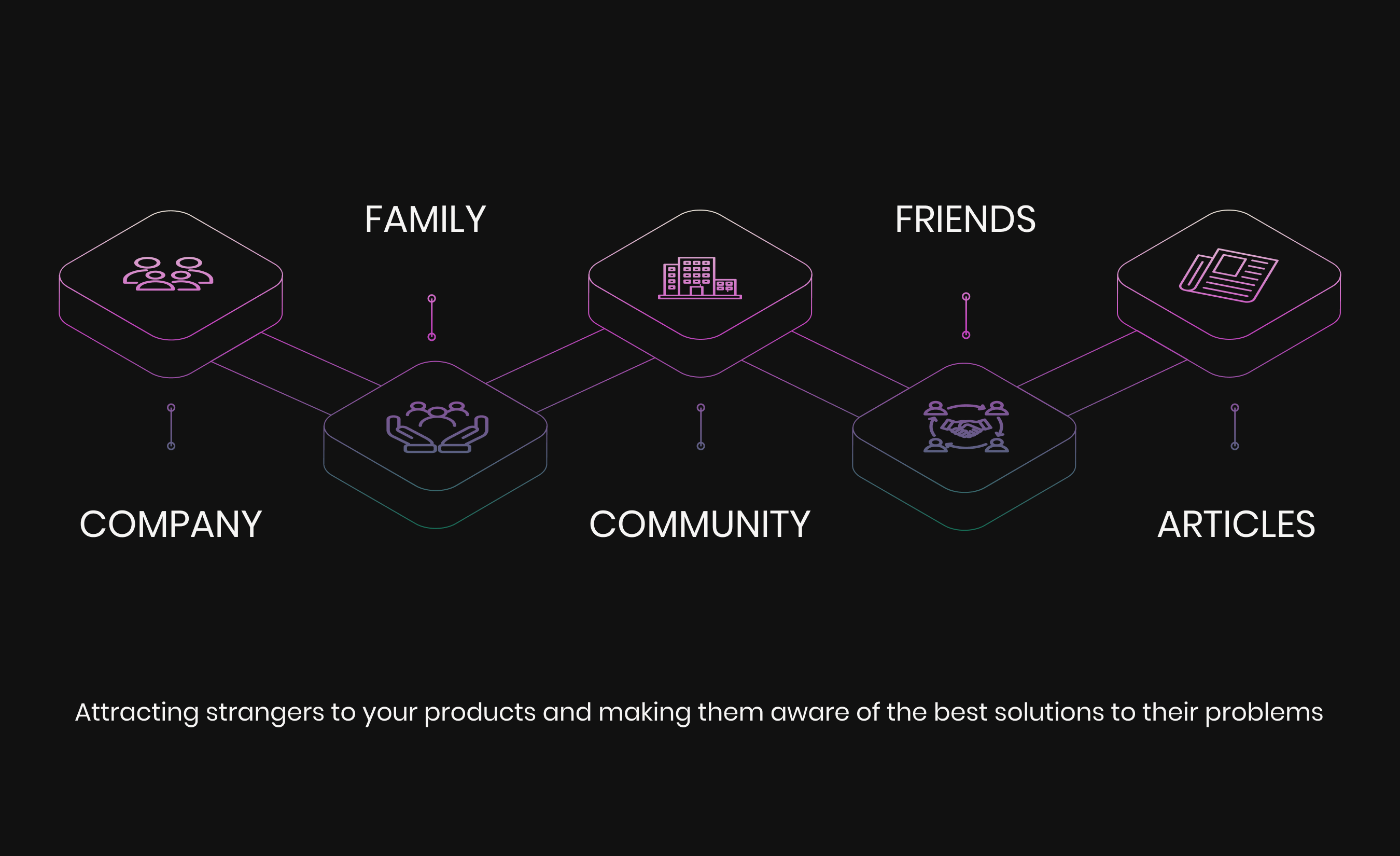
When designed well, a referral program becomes a self-reinforcing loop. Each new customer has the potential to bring in more users, who in turn can generate additional referrals. This compounding effect creates a growth engine that scales naturally over time. For many successful SaaS companies, referrals have played a decisive role in achieving rapid adoption and market dominance.
Referral Formula
Viral Coefficient (K-Factor) = (Number of invitations sent × Conversion rate) ÷ Total users
Dropbox Case Study
Dropbox famously used referrals to skyrocket growth. By giving both the referrer and referee extra storage, they built a viral loop that drove signups from 100,000 to 4 million users in just 15 months.
Referral Tactics
- Offer double-sided rewards such as credits, discounts, or additional storage
- Trigger sharing prompts after activation milestones
- Place referral CTAs in thank-you pages, dashboards, or email signatures
Wrapping It Up!
The AARRR framework is not meant to focus on a single stage in isolation. Each part of the funnel builds on the one before it, creating a connected path to growth.
- Bring in customers with clear intent and well-targeted acquisition strategies.
- Guide them to value quickly so activation feels natural and rewarding.
- Keep them engaged through consistent support and meaningful retention tactics.
- Turn engagement into revenue with models that are both scalable and predictable.
- Inspire referrals so that satisfied users bring in the next wave of customers.
When these stages work together, Pirate Metrics transform into a complete growth system. Rather than chasing short-term wins, your SaaS gains a reliable, data-driven playbook for long-term success and sustainable expansion.
Frequently Asked Questions
What is AARRR in SaaS?
AARRR stands for Acquisition, Activation, Retention, Revenue, and Referrals. It is a growth framework created by Dave McClure to track SaaS performance across the customer lifecycle.
How do you measure activation?
Activation is measured using the formula: (Number of activated users ÷ Total signups) × 100.
What is a good retention rate?
A monthly churn rate under 5 percent or a Net Revenue Retention above 100 percent is considered healthy.
How do you calculate SaaS revenue metrics?
Revenue is typically measured with MRR, ARR, ARPU, and LTV formulas, often compared against CAC to evaluate sustainability.
Why is AARRR called Pirate Metrics?
The AARRR framework, often called Pirate Metrics or the AARRR funnel, is a system of metrics designed to track and influence key user behaviors that drive business growth. The acronym represents acquisition, activation, retention, revenue, and referral.







.svg)


.svg)

